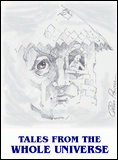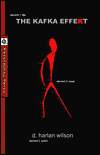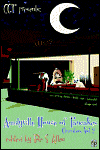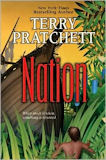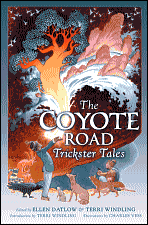
Coyote Road, edited by Ellen Datlow, Terri Windling
Book Review by Pete S. Allen
Have you read this book?
So how do I get invited to participate in a Datlow anthology? I mean, apart from the "World's Best..." anthologies, which are pretty much selections from the previous year's publications. No, I'm talking about one of the many and various other anthologies that you never hear about until they hit the shelves. For example...
The Coyote Road: Trickster Tales is a gorgeous new anthology from Viking containing tales written about or influenced by the Trickster archetype that pervades cultures around the world. Edited by Ellen Datlow and Terri Windling, it contains twenty-six stories and poems (heavy on the stories) from current and rising stars in the fantasy and folklore fields, as well as fantastic essay from Terri Windling about the Trickster archetype and myths. It is the third in series of folklore-y type anthologies, the first and second being "The Green Man" and "The Fairy Reel" respectively. The book is marketed toward young adult readers, for no reason that I can determine unless it is that adults don't buy anthologies as often as school libraries do.
If this IS the reason, it's a shame, because this book is as good as any collection of stories under any arbitrary theme that I've seen lately. I'm a fan of anthologies, so my opinion may be somewhat suspect on the topic of anthologies in general. So as a book, does this one work?
Overall, yes. The introduction from both editors and the essay on the Trickster archetype go a long way toward setting up the reader's expectations for the book. Terri Windling gives a pretty complete and competent presentation on the various Trickster myths, describing the major tropes one can expect from such myths, particularly, the amorality of the Trickster and the indifference to others in regard to the results of his (almost always his, she says) actions. In other words, Trickster isn't a patron of people, though he will help them on a whim, or if it is in his best interest. His selfishness can get him in trouble, and he often finds himself of the wrong end of someone's (usually a divine someone) wrath.
And then we get the stories. I'm curious whether the editors sent the essay along with their request for a Trickster tale. By and large, most of the stories are clever variations and well-written accounts with Trickster elements, but enough seem to miss the point that I'm not sure everybody was clear on what we were going for here. Some completely miss the boat. Some are very good stories, and some are not. How much you enjoy the book may depend on how invested you are in the theme -- some of the good stories miss the point, and some of the poorer stories get it, but don't seem to do anything with it.
Unfortunately, the editors chose the one story that seemed to neither grasp the point nor be a very good story to open the book -- "One Odd Shoe" by Pat Murphy has an avenging Coyote guarding the hearts and characters of young female archaeologists, in a trite and unconvincing "folk" tale. Things do get better, however, but before I give a complete breakdown, let me say that in general, the rest of the book works well -- enough of the stories that don't quite seem to get the point are good enough stories that one can forgive their not completely meshing with the theme.
Some gems in the book: Will Shetterly's "Black Rock Blues" is a delightful imagining of West African orishas in a pseudo-gangster setting, which works remarkably well, "Wagers of Gold Mountain," by Steve Berman is a fantastic tale of two Tricksters colliding in the blended culture of 19th century San Francisco, "The Fiddler of Bayou Teche," by Delia Sherman and "Honored Guest" by Ellen Kushner are both excellent stories and excellent examples of non-divine tricksters, with the added bonus that fans of Kushner's Jessica Campion character get to see her again, Ellen Klages' "Friday Night at St. Cecilia's deserves a mention as a great story which is the first I'm aware of that contains both Clue and Queen Mab, and finally "The Evolution of Trickster Stories Among the Dogs of North Park After the Change," by Kij Johnson is a perfect tale to wrap up the book, giving the Coyote back to his people (about which I'll say no more). Also, the four poems, "Coyote Woman" (Carolyn Dunn), "How Raven Made His Bride" (Theodora Goss), "Uncle Tompa" (Midori Snyder) and "Kawaku Anansi Walks the World's Web" (Jane Yolen) are all fresh breaths, reminding us that Trickster tales aren't just for stories.
There are several more enjoyable stories in the book that for whatever reason don't make it to the gem list -- mostly because I'm being picky about their Tricksters' over-involvements with human agents, or other broken rules -- but are still worth mentioning: "The Listeners" by Nina Kiriki Hoffman, "A Tale for the Short Days," by Richard Bowes, and "Crow Roads" by Charles de Lint were all excellent stories but all involved a rescue of some sort, which seemed to miss the point of the trickster. "Cat of the World" (Michael Cadnum), "Uncle Bob Visits" (Caroline Stevermer),"The Constable of Abal" (Kelly Link), "A Reversal of Fortune" (Holly Black), "God Clown" (Carol Emshwiller), "The Other Labyrinth" (Jebediah Berry), "The Senorita and the Cactus Thorn" (Kim Antieau) and "The Dreaming Wind" (Jeffrey Ford) are all pleasant reads, but again, don't quite hit the gem level for some reason.
Really, there are only a very few sub-par stories, which is not too shabby for a book this size, and given the difficulty of the assignment. As well as the aforementioned "One Odd Shoe," the following stories lacked in either creativity, enjoyment, Trickster, or some combination of all three: "Realer Than You," by Christopher Barzak features a whiny teenage narrator feeling lost in Japan, until he meets a ghostly fox girl (who is decidedly not Tricky); "The Fortune Teller" by Patricia A. McKillip mentions in the author notes that the author had a hard time writing about Trickster, and sadly, it shows; "The Chamber Music of Animals" by Katherine Vaz is a cloying fairy tale of a stuffed orangutan saving a young man from cancer, which is one of two stories in the book which seems to be aimed at children (rather than written for children); "Always the Same Story" by Elizabeth E. Wein is the other.
I asked in the beginning how I get invited to play in the Datlow anthologies -- each of the stories/poems ends in an author bio and author notes, which is the reason that made me ask this VERY rhetorical question (I have no illusions of being asked to play). Some of the authors in the book are well-established names in either fantasy or young adult (or both) literature. Many are not that established, and it is from some of the newer authors that we get some of the freshest material, and it is from some of the old pros we get to see what makes them pros. Writing to assignment can be a tricky business, but overall it works for this book, and I enjoyed it enough that I will be looking for the first anthologies in this series, and watching for new ones to appear.
But then, I like anthologies.
The Coyote Road: Trickster Tales is a gorgeous new anthology from Viking containing tales written about or influenced by the Trickster archetype that pervades cultures around the world. Edited by Ellen Datlow and Terri Windling, it contains twenty-six stories and poems (heavy on the stories) from current and rising stars in the fantasy and folklore fields, as well as fantastic essay from Terri Windling about the Trickster archetype and myths. It is the third in series of folklore-y type anthologies, the first and second being "The Green Man" and "The Fairy Reel" respectively. The book is marketed toward young adult readers, for no reason that I can determine unless it is that adults don't buy anthologies as often as school libraries do.
If this IS the reason, it's a shame, because this book is as good as any collection of stories under any arbitrary theme that I've seen lately. I'm a fan of anthologies, so my opinion may be somewhat suspect on the topic of anthologies in general. So as a book, does this one work?
Overall, yes. The introduction from both editors and the essay on the Trickster archetype go a long way toward setting up the reader's expectations for the book. Terri Windling gives a pretty complete and competent presentation on the various Trickster myths, describing the major tropes one can expect from such myths, particularly, the amorality of the Trickster and the indifference to others in regard to the results of his (almost always his, she says) actions. In other words, Trickster isn't a patron of people, though he will help them on a whim, or if it is in his best interest. His selfishness can get him in trouble, and he often finds himself of the wrong end of someone's (usually a divine someone) wrath.
And then we get the stories. I'm curious whether the editors sent the essay along with their request for a Trickster tale. By and large, most of the stories are clever variations and well-written accounts with Trickster elements, but enough seem to miss the point that I'm not sure everybody was clear on what we were going for here. Some completely miss the boat. Some are very good stories, and some are not. How much you enjoy the book may depend on how invested you are in the theme -- some of the good stories miss the point, and some of the poorer stories get it, but don't seem to do anything with it.
Unfortunately, the editors chose the one story that seemed to neither grasp the point nor be a very good story to open the book -- "One Odd Shoe" by Pat Murphy has an avenging Coyote guarding the hearts and characters of young female archaeologists, in a trite and unconvincing "folk" tale. Things do get better, however, but before I give a complete breakdown, let me say that in general, the rest of the book works well -- enough of the stories that don't quite seem to get the point are good enough stories that one can forgive their not completely meshing with the theme.
Some gems in the book: Will Shetterly's "Black Rock Blues" is a delightful imagining of West African orishas in a pseudo-gangster setting, which works remarkably well, "Wagers of Gold Mountain," by Steve Berman is a fantastic tale of two Tricksters colliding in the blended culture of 19th century San Francisco, "The Fiddler of Bayou Teche," by Delia Sherman and "Honored Guest" by Ellen Kushner are both excellent stories and excellent examples of non-divine tricksters, with the added bonus that fans of Kushner's Jessica Campion character get to see her again, Ellen Klages' "Friday Night at St. Cecilia's deserves a mention as a great story which is the first I'm aware of that contains both Clue and Queen Mab, and finally "The Evolution of Trickster Stories Among the Dogs of North Park After the Change," by Kij Johnson is a perfect tale to wrap up the book, giving the Coyote back to his people (about which I'll say no more). Also, the four poems, "Coyote Woman" (Carolyn Dunn), "How Raven Made His Bride" (Theodora Goss), "Uncle Tompa" (Midori Snyder) and "Kawaku Anansi Walks the World's Web" (Jane Yolen) are all fresh breaths, reminding us that Trickster tales aren't just for stories.
There are several more enjoyable stories in the book that for whatever reason don't make it to the gem list -- mostly because I'm being picky about their Tricksters' over-involvements with human agents, or other broken rules -- but are still worth mentioning: "The Listeners" by Nina Kiriki Hoffman, "A Tale for the Short Days," by Richard Bowes, and "Crow Roads" by Charles de Lint were all excellent stories but all involved a rescue of some sort, which seemed to miss the point of the trickster. "Cat of the World" (Michael Cadnum), "Uncle Bob Visits" (Caroline Stevermer),"The Constable of Abal" (Kelly Link), "A Reversal of Fortune" (Holly Black), "God Clown" (Carol Emshwiller), "The Other Labyrinth" (Jebediah Berry), "The Senorita and the Cactus Thorn" (Kim Antieau) and "The Dreaming Wind" (Jeffrey Ford) are all pleasant reads, but again, don't quite hit the gem level for some reason.
Really, there are only a very few sub-par stories, which is not too shabby for a book this size, and given the difficulty of the assignment. As well as the aforementioned "One Odd Shoe," the following stories lacked in either creativity, enjoyment, Trickster, or some combination of all three: "Realer Than You," by Christopher Barzak features a whiny teenage narrator feeling lost in Japan, until he meets a ghostly fox girl (who is decidedly not Tricky); "The Fortune Teller" by Patricia A. McKillip mentions in the author notes that the author had a hard time writing about Trickster, and sadly, it shows; "The Chamber Music of Animals" by Katherine Vaz is a cloying fairy tale of a stuffed orangutan saving a young man from cancer, which is one of two stories in the book which seems to be aimed at children (rather than written for children); "Always the Same Story" by Elizabeth E. Wein is the other.
I asked in the beginning how I get invited to play in the Datlow anthologies -- each of the stories/poems ends in an author bio and author notes, which is the reason that made me ask this VERY rhetorical question (I have no illusions of being asked to play). Some of the authors in the book are well-established names in either fantasy or young adult (or both) literature. Many are not that established, and it is from some of the newer authors that we get some of the freshest material, and it is from some of the old pros we get to see what makes them pros. Writing to assignment can be a tricky business, but overall it works for this book, and I enjoyed it enough that I will be looking for the first anthologies in this series, and watching for new ones to appear.
But then, I like anthologies.
|
Click here to buy Coyote Road, edited by Ellen Datlow, Terri Windling on Amazon
|
Coyote Road, edited by Ellen Datlow, Terri Windling on Amazon

| More Books You Might Like |
Comment on Coyote Road, edited by Ellen Datlow, Terri Windling
| Comments on Coyote Road, edited by Ellen Datlow, Terri Windling |
| There are no comments on this book. |
